Abstract
1. The electromechanical effects of two enantiomers, S-16257-2 (S57) and S-16260-2 (R60), were studied and compared in guinea-pig isolated atria and ventricular papillary muscles. The possible stereoselectivity of the interaction on the cardiac Na+ channel was analysed by comparing the effects of the two enantiomers on the onset and recovery kinetics of the frequency-dependent Vmax block. 2. In spontaneously beating right atria, S57 and R60 (10(-8)M-10(-4M) exerted a negative chronotropic effect (pIC50 = 5.07 +/- 0.19 and 4.76 +/- 0.18, respectively) and prolonged the sinus node recovery time, this effect being more marked with S57. In electrically driven left atria, S57 decreased (P < 0.05) contractile force only at 10(-4M) and R60 at concentrations > or = 5 x 10(-5M), whereas in papillary muscles the negative inotropic effect appeared at concentrations > 10(-5M). 3. In papillary muscles driven at 1 Hz, S57 and R60 at concentrations higher than 5 x 10(-6M) produced a concentration-dependent decrease in the maximum upstroke velocity (Vmax) and amplitude of the cardiac action potential without altering the resting membrane potential or the action potential duration. S57 and R60 had no effect on the characteristics of the slow action potentials elicited by isoprenaline in ventricular muscle fibres depolarized in high K+ (27 mM) solution. 4. At 5 x 10(-5M), S57 and R60 produced a small tonic Vmax block. However, in muscles driven at rates between 0.5 and 3 Hz both enantiomers produced an exponential decline in Vmax (frequency-dependent Vmax block) which augmented at higher rates of stimulation.(ABSTRACT TRUNCATED AT 250 WORDS)
Full text
PDF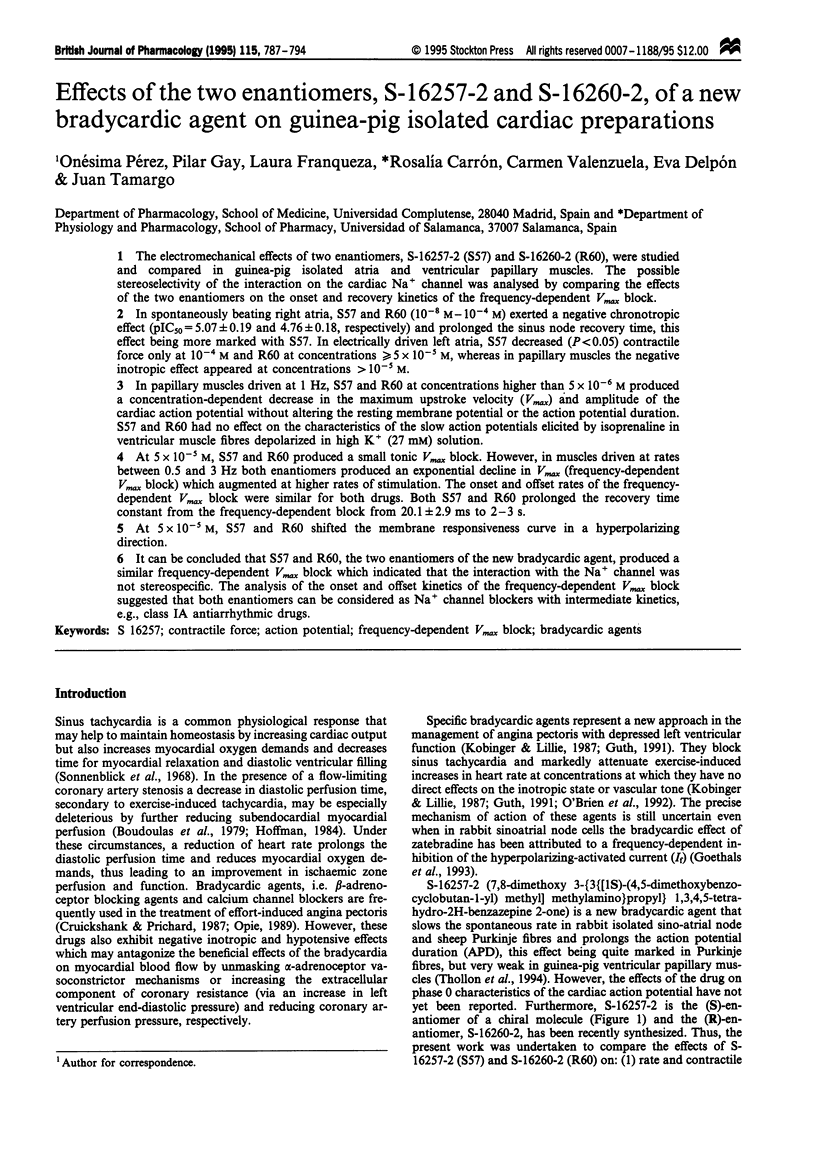
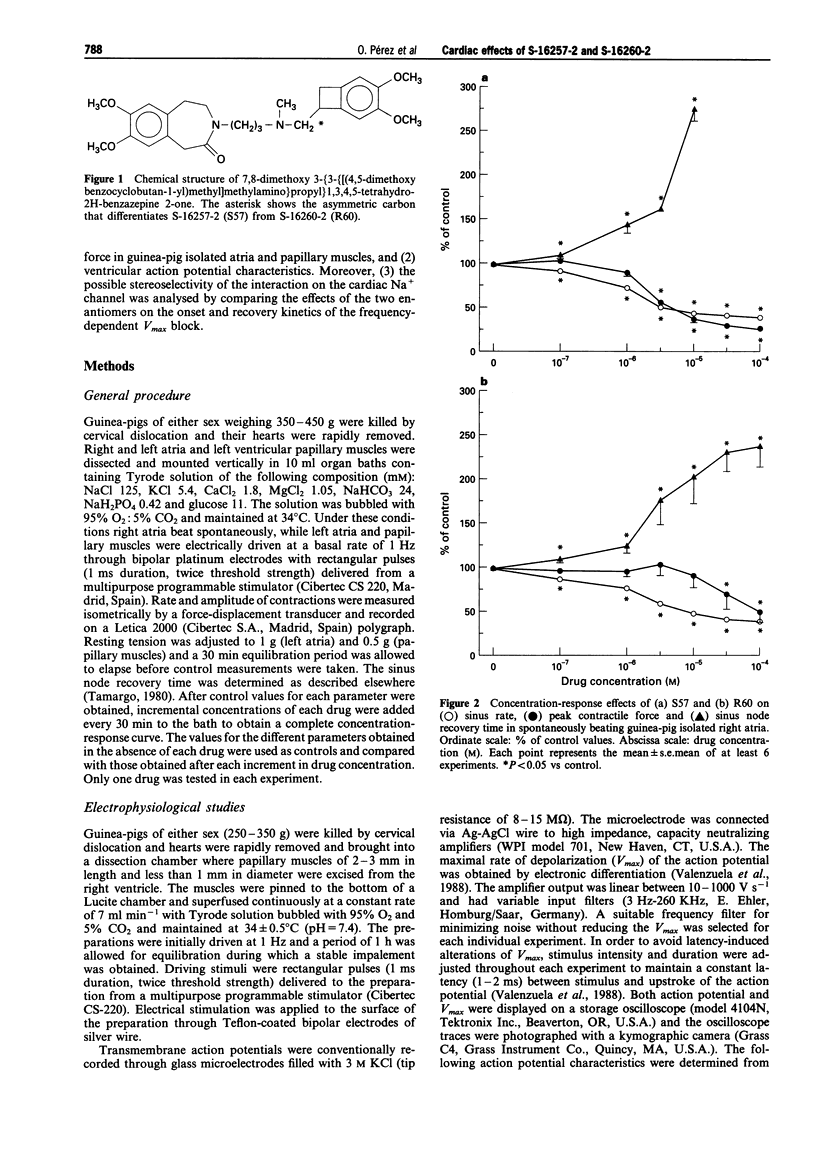
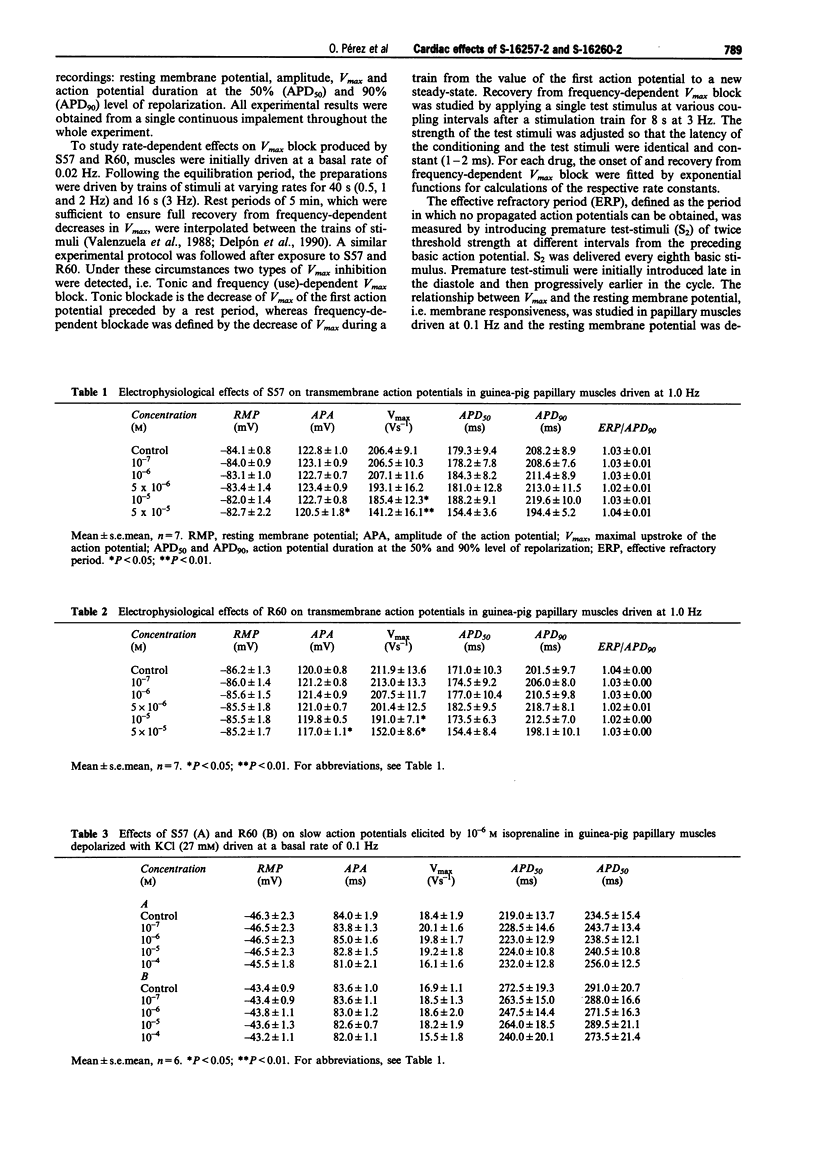
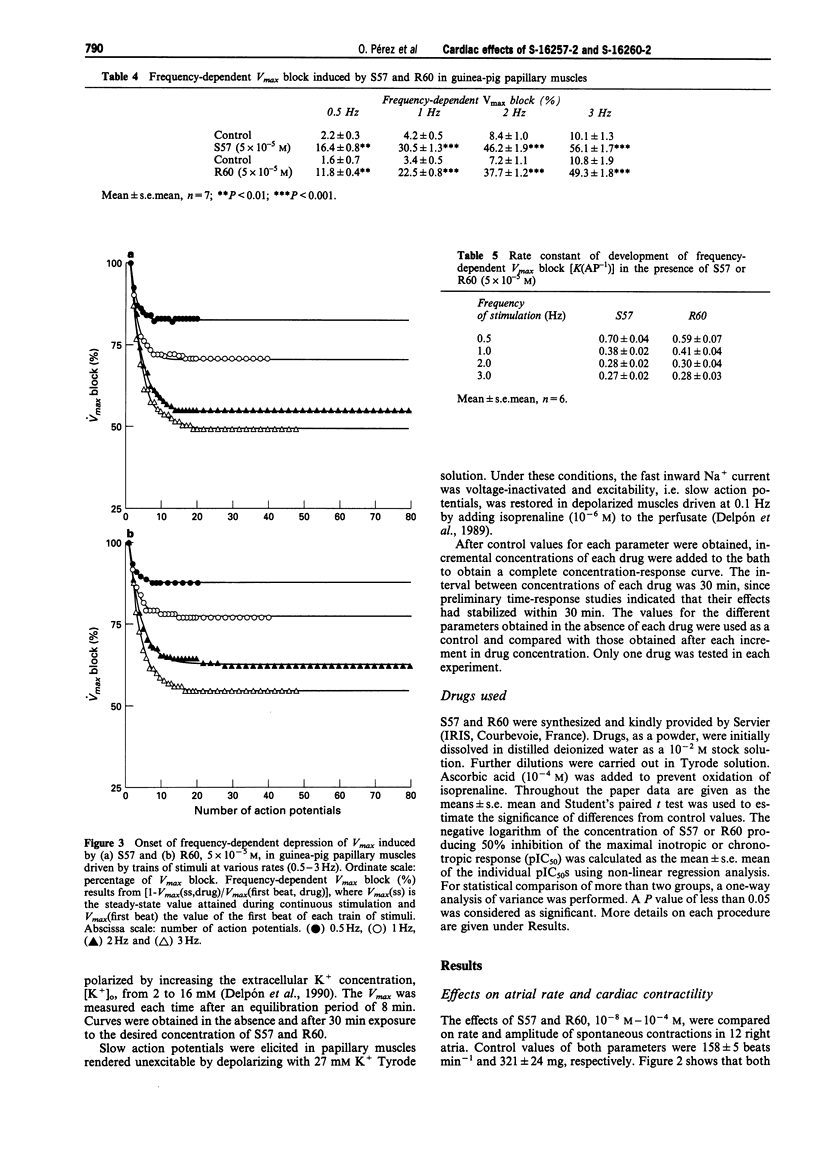
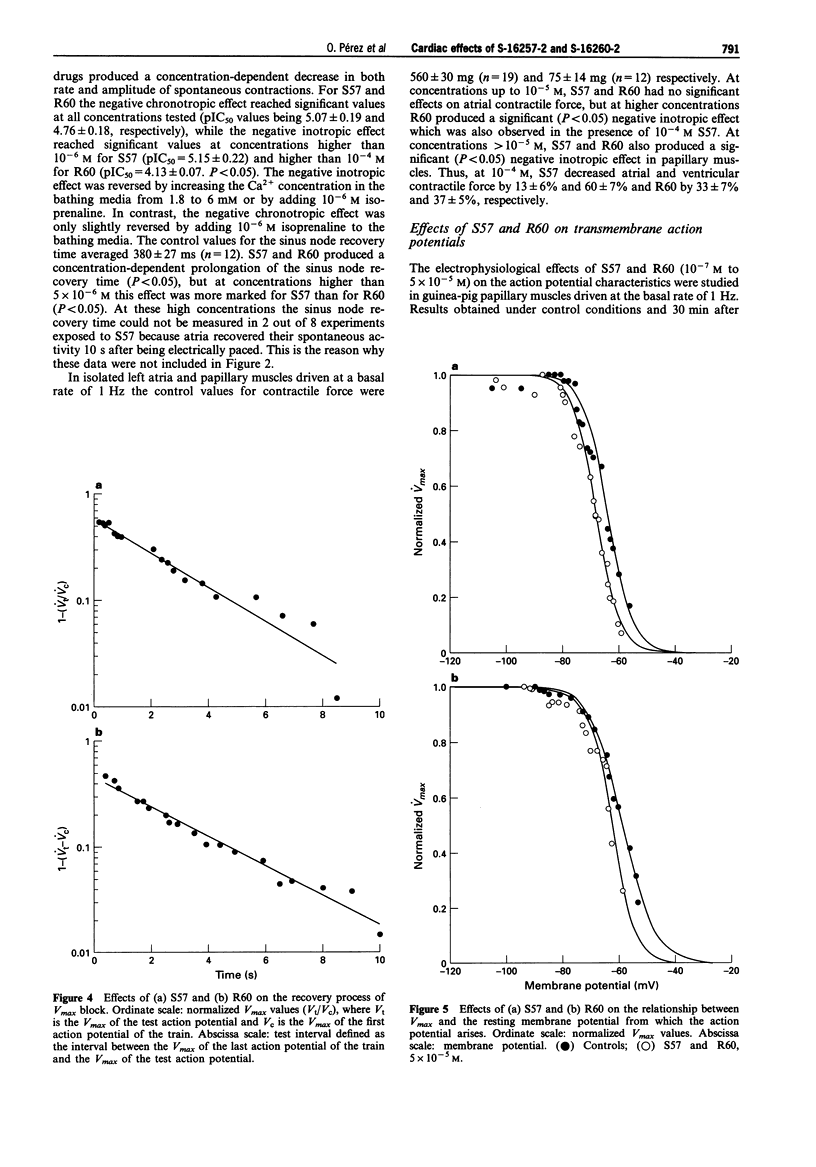
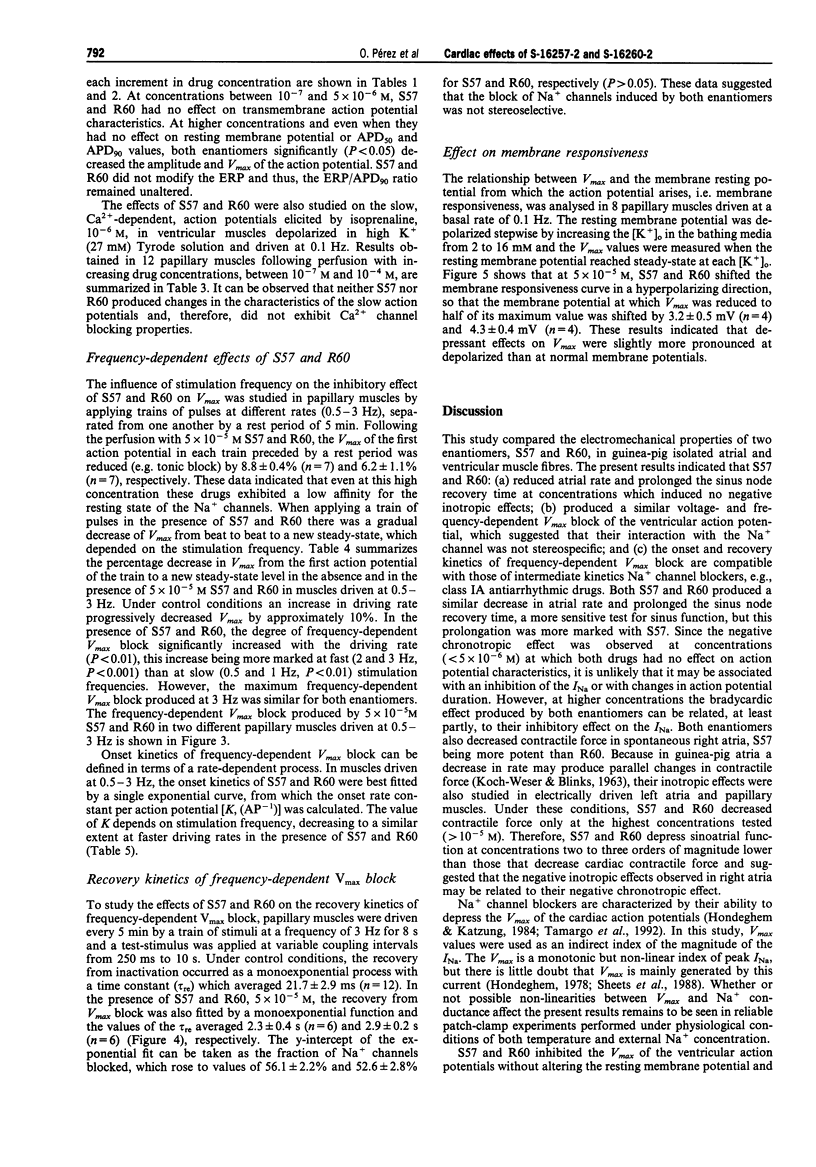
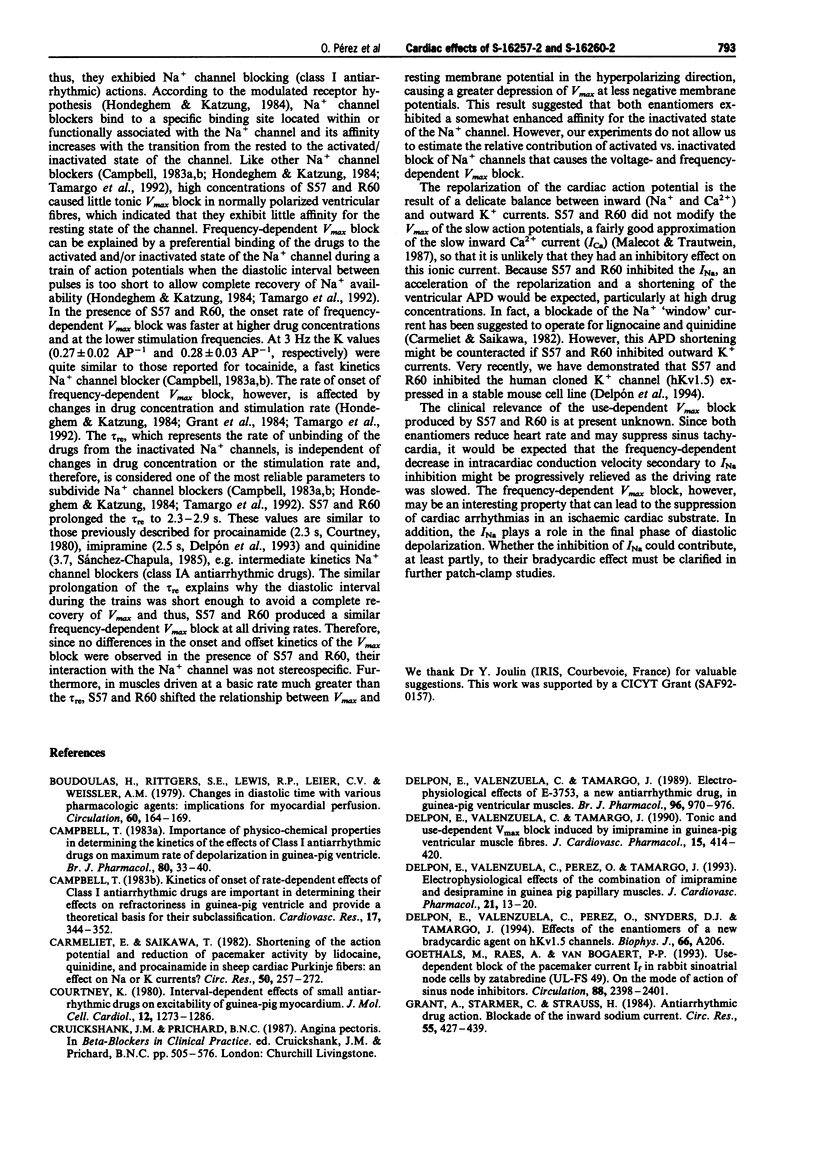
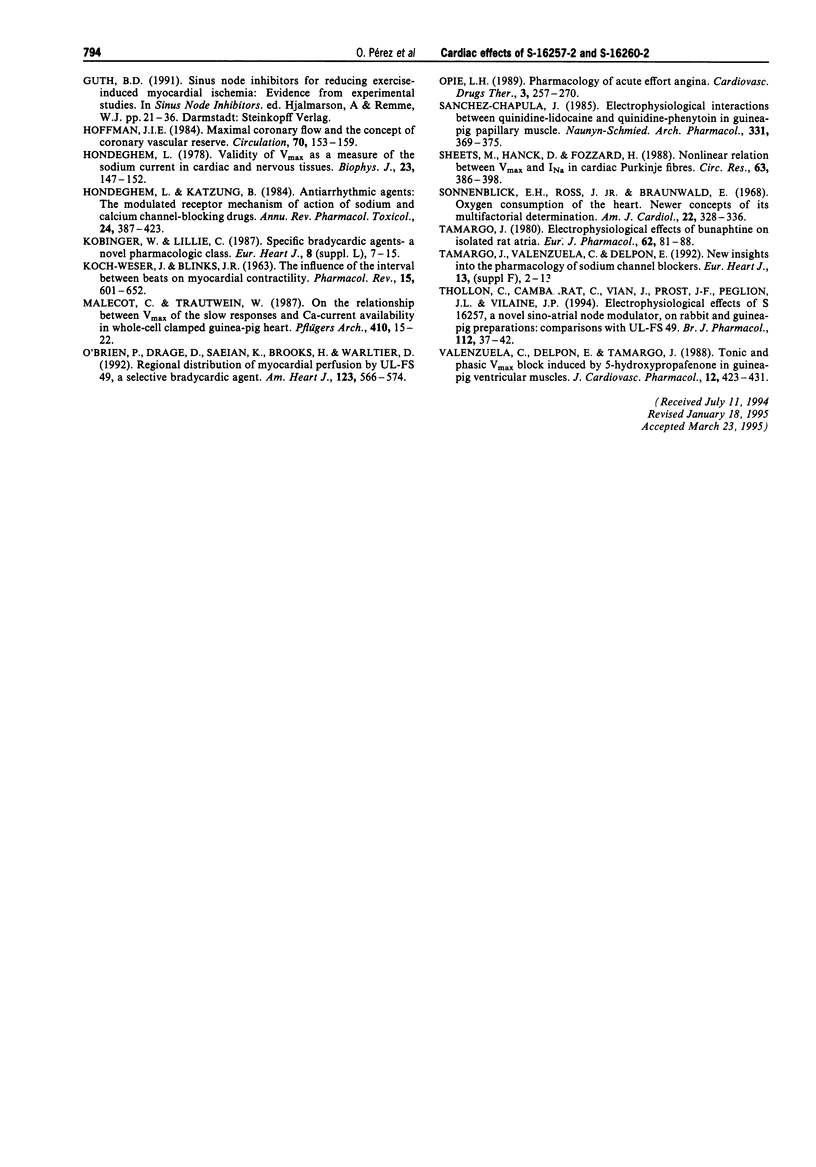
Selected References
These references are in PubMed. This may not be the complete list of references from this article.
- Boudoulas H., Rittgers S. E., Lewis R. P., Leier C. V., Weissler A. M. Changes in diastolic time with various pharmacologic agents: implication for myocardial perfusion. Circulation. 1979 Jul;60(1):164–169. doi: 10.1161/01.cir.60.1.164. [DOI] [PubMed] [Google Scholar]
- Campbell T. J. Importance of physico-chemical properties in determining the kinetics of the effects of Class I antiarrhythmic drugs on maximum rate of depolarization in guinea-pig ventricle. Br J Pharmacol. 1983 Sep;80(1):33–40. doi: 10.1111/j.1476-5381.1983.tb11046.x. [DOI] [PMC free article] [PubMed] [Google Scholar]
- Campbell T. J. Kinetics of onset of rate-dependent effects of Class I antiarrhythmic drugs are important in determining their effects on refractoriness in guinea-pig ventricle, and provide a theoretical basis for their subclassification. Cardiovasc Res. 1983 Jun;17(6):344–352. doi: 10.1093/cvr/17.6.344. [DOI] [PubMed] [Google Scholar]
- Carmeliet E., Saikawa T. Shortening of the action potential and reduction of pacemaker activity by lidocaine, quinidine, and procainamide in sheep cardiac purkinje fibers. An effect on Na or K currents? Circ Res. 1982 Feb;50(2):257–272. doi: 10.1161/01.res.50.2.257. [DOI] [PubMed] [Google Scholar]
- Courtney K. R. Interval-dependent effects of small antiarrhythmic drugs on excitability of guinea-pig myocardium. J Mol Cell Cardiol. 1980 Nov;12(11):1273–1286. doi: 10.1016/0022-2828(80)90071-1. [DOI] [PubMed] [Google Scholar]
- Delpón E., Valenzuela C., Pérez O., Tamargo J. Electrophysiological effects of the combination of imipramine and desipramine in guinea pig papillary muscles. J Cardiovasc Pharmacol. 1993 Jan;21(1):13–20. doi: 10.1097/00005344-199301000-00003. [DOI] [PubMed] [Google Scholar]
- Delpón E., Valenzuela C., Tamargo J. Electrophysiological effects of E-3753, a new antiarrhythmic drug, in guinea-pig ventricular muscle. Br J Pharmacol. 1989 Apr;96(4):970–976. doi: 10.1111/j.1476-5381.1989.tb11909.x. [DOI] [PMC free article] [PubMed] [Google Scholar]
- Delpón E., Valenzuela C., Tamargo J. Tonic and frequency-dependent Vmax block induced by imipramine in guinea pig ventricular muscle fibers. J Cardiovasc Pharmacol. 1990 Mar;15(3):414–420. doi: 10.1097/00005344-199003000-00011. [DOI] [PubMed] [Google Scholar]
- Goethals M., Raes A., van Bogaert P. P. Use-dependent block of the pacemaker current I(f) in rabbit sinoatrial node cells by zatebradine (UL-FS 49). On the mode of action of sinus node inhibitors. Circulation. 1993 Nov;88(5 Pt 1):2389–2401. doi: 10.1161/01.cir.88.5.2389. [DOI] [PubMed] [Google Scholar]
- Grant A. O., Starmer C. F., Strauss H. C. Antiarrhythmic drug action. Blockade of the inward sodium current. Circ Res. 1984 Oct;55(4):427–439. doi: 10.1161/01.res.55.4.427. [DOI] [PubMed] [Google Scholar]
- Hoffman J. I. Maximal coronary flow and the concept of coronary vascular reserve. Circulation. 1984 Aug;70(2):153–159. doi: 10.1161/01.cir.70.2.153. [DOI] [PubMed] [Google Scholar]
- Hondeghem L. M., Katzung B. G. Antiarrhythmic agents: the modulated receptor mechanism of action of sodium and calcium channel-blocking drugs. Annu Rev Pharmacol Toxicol. 1984;24:387–423. doi: 10.1146/annurev.pa.24.040184.002131. [DOI] [PubMed] [Google Scholar]
- Hondeghem L. M. Validity of Vmax as a measure of the sodium current in cardiac and nervous tissues. Biophys J. 1978 Jul;23(1):147–152. doi: 10.1016/S0006-3495(78)85439-3. [DOI] [PMC free article] [PubMed] [Google Scholar]
- KOCH-WESER J., BLINKS J. R. THE INFLUENCE OF THE INTERVAL BETWEEN BEATS ON MYOCARDIAL CONTRACTILITY. Pharmacol Rev. 1963 Sep;15:601–652. [PubMed] [Google Scholar]
- Kobinger W., Lillie C. Specific bradycardic agents--a novel pharmacological class? Eur Heart J. 1987 Dec;8 (Suppl 50):7–15. doi: 10.1093/eurheartj/8.suppl_l.7. [DOI] [PubMed] [Google Scholar]
- Malécot C. O., Trautwein W. On the relationship between V max of slow responses and Ca-current availability in whole-cell clamped guinea pig heart cells. Pflugers Arch. 1987 Sep;410(1-2):15–22. doi: 10.1007/BF00581890. [DOI] [PubMed] [Google Scholar]
- O'Brien P., Drage D., Saeian K., Brooks H. L., Warltier D. C. Regional redistribution of myocardial perfusion by UL-FS 49, a selective bradycardic agent. Am Heart J. 1992 Mar;123(3):566–574. doi: 10.1016/0002-8703(92)90492-e. [DOI] [PubMed] [Google Scholar]
- Opie L. H. Pharmacology of acute effort angina. Cardiovasc Drugs Ther. 1989 Jun;3 (Suppl 1):257–270. doi: 10.1007/BF00148470. [DOI] [PubMed] [Google Scholar]
- Sheets M. F., Hanck D. A., Fozzard H. A. Nonlinear relation between Vmax and INa in canine cardiac Purkinje cells. Circ Res. 1988 Aug;63(2):386–398. doi: 10.1161/01.res.63.2.386. [DOI] [PubMed] [Google Scholar]
- Sonnenblick E. H., Ross J., Jr, Braunwald E. Oxygen consumption of the heart. Newer concepts of its multifactoral determination. Am J Cardiol. 1968 Sep;22(3):328–336. doi: 10.1016/0002-9149(68)90117-3. [DOI] [PubMed] [Google Scholar]
- Sánchez-Chapula J. Electrophysiological interactions between quinidine-lidocaine and quinidine-phenytoin in guinea-pig papillary muscle. Naunyn Schmiedebergs Arch Pharmacol. 1985 Dec;331(4):369–375. doi: 10.1007/BF00500822. [DOI] [PubMed] [Google Scholar]
- Tamargo J. Electrophysiological effects of bunaphtine on isolated rat atria. Eur J Pharmacol. 1980 Mar 7;62(1):81–88. doi: 10.1016/0014-2999(80)90483-5. [DOI] [PubMed] [Google Scholar]
- Tamargo J., Valenzuela C., Delpón E. New insights into the pharmacology of sodium channel blockers. Eur Heart J. 1992 Nov;13 (Suppl F):2–13. doi: 10.1093/eurheartj/13.suppl_f.2. [DOI] [PubMed] [Google Scholar]
- Thollon C., Cambarrat C., Vian J., Prost J. F., Peglion J. L., Vilaine J. P. Electrophysiological effects of S 16257, a novel sino-atrial node modulator, on rabbit and guinea-pig cardiac preparations: comparison with UL-FS 49. Br J Pharmacol. 1994 May;112(1):37–42. doi: 10.1111/j.1476-5381.1994.tb13025.x. [DOI] [PMC free article] [PubMed] [Google Scholar]
- Valenzuela C., Delpón E., Tamargo J. Tonic and phasic Vmax block induced by 5-hydroxypropafenone in guinea pig ventricular muscles. J Cardiovasc Pharmacol. 1988 Oct;12(4):423–431. doi: 10.1097/00005344-198810000-00007. [DOI] [PubMed] [Google Scholar]


